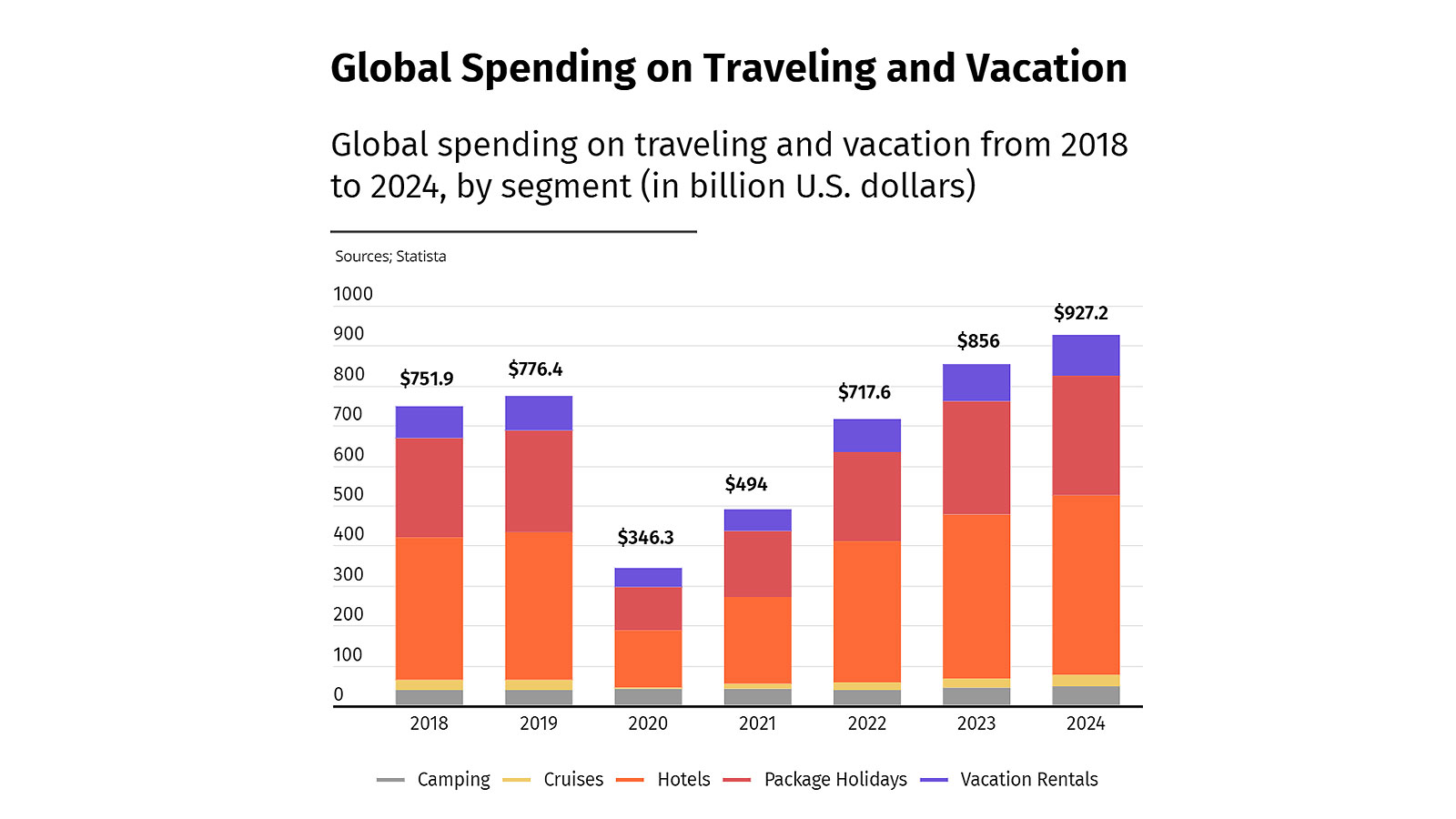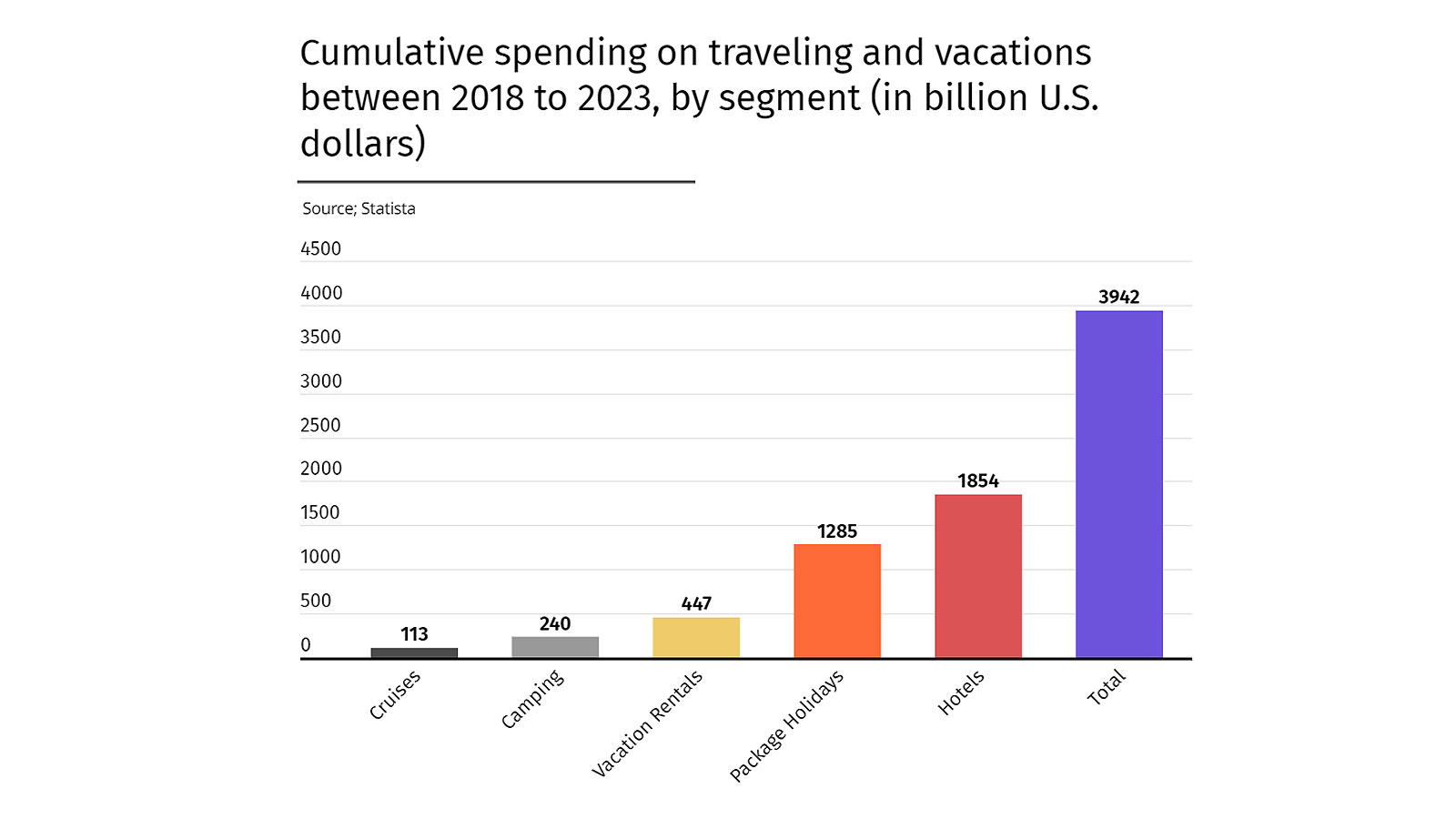Travel
People worldwide have spent almost $4 trillion on traveling and vacation in the past five years

Europeans are by far the biggest spenders on vacations and traveling
Although it took four years for the global tourism sector to fully recover from the COVID-19 hit, people worldwide have still spent hundreds of billions of dollars each year on traveling and vacation. In 2024, global travel and tourism revenues are expected to jump by 8.3% and hit almost $930 billion, the highest figure in the market`s history. But the cumulative figures for the past five years are even more impressive.
According to data presented by Stocklytics.com, people worldwide have spent almost $4 trillion on traveling and vacations in the past five years.
Hotels Make Almost Half the Total Spending with a Five-Year Revenue of $1.85 Trillion
Before the COVID-19 pandemic, the global tourism sector had seen almost uninterrupted growth for decades, with hundreds of billions of dollars spent on hotels, cruises, vacation rentals, and package holidays each year. That changed in 2020 and 2021, the years that brought the steepest revenue drop this market had ever seen. Three years later, the entire sector fully recovered, although still vulnerable to global economic conditions. And while the aftermath of the COVID-19 hit is quite severe, people worldwide continued spending hundreds of billions of dollars on vacation and traveling, even when the market was at its lowest point.

According to Statista Market Insights, between 2018 and 2023, people worldwide spent $3.95 trillion on vacation and traveling. This impressive figure is even more interesting considering that over $840 billion was spent in 2020 and 2021 when the market was down.
Statistics also show hotels brought far more money than any other market segment in the past five years. Since 2018, people worldwide have spent more than $1.85 trillion on hotel vacations, almost 45% more than on package holidays, and more than on camping, cruises, and vacation rentals combined. Package holidays ranked as the second-largest revenue stream, with $1.28 trillion in five-year spending. As the third-largest revenue stream, vacation rentals saw only one-third of that figure, or $448 billion in the past five years. Far below, camping and cruises follow with $240 billion and $113 billion in revenue, respectively.

Europeans Spent the Most on Vacation and Traveling, over $1.2 Trillion in Five Years
The Statista survey also showed that Europeans are by far the biggest spenders on vacations and traveling. Between 2018 and 2023, the residents of the old continent have spent a whopping $1.2 trillion on vacation and traveling, almost 40% more than Americans and twice more than Chinese.
Americans were the only nation close to Europeans in total spending, with $917.7 billion spent on vacation and travel since 2018. China, the world`s second-largest nation, is far below these figures. Statistics show that the Chinese have spent $666 billion on traveling and vacation in the past five years, almost 30% less than Americans and nearly twice less than Europeans.
Vicky is the co-founder of TravelDailyNews Media Network where she is the Editor-in Chief. She is also responsible for the daily operation and the financial policy. She holds a Bachelor’s degree in Tourism Business Administration from the Technical University of Athens and a Master in Business Administration (MBA) from the University of Wales.
She has many years of both academic and industrial experience within the travel industry. She has written/edited numerous articles in various tourism magazines.
Travel
Groups360 Launches Enterprise Meetings Solution

Meeting planning platform provider Groups360 this week launched GroupSync Planner Plus, a meeting planning and booking solution the company said has a “specialized set of features” that are “designed for corporate teams needing a standardized request and booking process.”
The platform appears to be tailored to matrixed organizations that may require multiple approval processes to initiate a meeting, followed by a planning process controlled by policy and cost guardrails configured into the planning and booking workflow. The platform includes a meeting request form and reporting tools for financial accountability. The company said additional features would be available “soon,” including the ability to apply a master service agreement to all request-for-proposal and booking activities and the ability to flag or preference a given company’s pre-negotiated hotel properties, brands or chains.
One of the differentiators for Groups360 is the ability to display live, real-time rates and available rooms and meetings at hotels participating in its marketplace. That said, the number of properties is lower at 25,000 globally than in some other comparative meeting planning tools. Groupize—another platform that announced enterprise-level upgrades this week—for example, says it offers more than 250,000 hotels and venues in its global marketplace, but it may not have access to real-time shelves for content availability. That requires key integrations with hotel property management systems and, given the nature of hotel franchise and management models, isn’t necessarily straightforward and requires at minimum a chain-by-chain approach.
Even with the smaller marketplace, Groups360’s Planner Plus could offer some advantages. The integrated nature of the content retrieval enables instant booking for small meetings of 10 to 25 sleeping rooms and event space for up to 50 attendees, but that is only for “participating” properties—not everything in the Groups360 marketplace. Instant-book tools include audiovisual requirements, catering and other services without the need to engage in the RFP process.
The enterprise tools, with MSAs applied and preferred property lists, won’t necessarily overlap with that instant-book proposition. However, the more sophisticated toolset will support in other ways, allowing enterprise companies to define meeting types and set standards and policies around those types—to manage costs, quality and attendee experience. Once the meeting type standards are applied and requirements for the individual meeting are established, a simplified RFP process tracks and organizes hotel responses into a single dashboard for the organizer to compare and ease decision making.
“One of the inherent challenges that Planner Plus solves for company meeting and event planners is organizing and standardizing the disparate processes that companies use to plan and track various types of events,” said Groups360 SVP product Christian Oliver. “We have developed a comprehensive system that allows corporate planners and teams to easily build and track all meeting data, including event criteria, budgets, expenditure and tiered approvals within a single portal that is accessible to all company stakeholders. Since it’s built within GroupSync, it also provides powerful hotel sourcing and booking capabilities that have been proven to save significant time and money—both valuable resources for any size organization.”
Travel
Celebrity Cruises sees ‘a ton of support’ from UK agents


President reports Apex ‘doing exceptionally well’ in Southampton
Source link
Travel
Bryan Terzi joins AutoCamp as CMO

Bryan Terzi joins AutoCamp as Chief Marketing Officer, leveraging over two decades of marketing expertise to enhance the brand’s outdoor hospitality experience.
Bryan Terzi is the new Chief Marketing Officer at AutoCamp, a pioneering brand in the hospitality industry known for revolutionizing outdoor travel. With over two decades of global marketing expertise, Terzi has lead multiple renowned hospitality brands across an array of disciplines. In his previous role as Group Vice President of Marketing at Sage Hospitality, a leading hotel and restaurant management company, Terzi orchestrated strategic marketing campaigns for a diverse portfolio of over 60 hotels and 40 restaurants.
During his time there he successfully launched 12 new hotels, repositioned three existing restaurants, spearheaded the creation of a new CRM program, and established the Sage corporate marketing team as an integral part of the business. Prior to this, in his tenure as Vice President of Marketing at Relevant Group, he played a pivotal role in introducing upscale culinary concepts (most notably, the acclaimed Italian restaurant, Mother Wolf) to Hollywood’s vibrant entertainment district. Terzi’s professional journey also includes significant contributions at Sydell Group, (the creators of celebrated hotel brands like NoMad, LINE, and Freehand), as well as Starwood Hotels & Resorts, MGM, Thompson Hotels, and sbe Entertainment – where he consistently excelled in guiding cross-functional teams across diverse organizational levels.
Transitioning from a successful career predominantly focused on urban corporate brands, Bryan looks forward to directing his expertise towards championing wellness and advocating the benefits of outdoor travel. As he spearheads the expansion of the AutoCamp brand, he eagerly anticipates embracing this new chapter dedicated to enhancing the outdoor hospitality experience.
A pioneering brand in hospitality, AutoCamp has revolutionized outdoor travel by redefining the iconic camping experience. Blending the traditional elements of sleeping under the stars with the service and design-forward thinking of a boutique hotel, each AutoCamp location creates a unique experience that encourages guests to immerse themselves in nature – without sacrificing the comforts of high-end accommodations. Since its inception, AutoCamp has been the premier basecamp for the modern adventurer.
Vicky is the co-founder of TravelDailyNews Media Network where she is the Editor-in Chief. She is also responsible for the daily operation and the financial policy. She holds a Bachelor’s degree in Tourism Business Administration from the Technical University of Athens and a Master in Business Administration (MBA) from the University of Wales.
She has many years of both academic and industrial experience within the travel industry. She has written/edited numerous articles in various tourism magazines.
-

 African History5 years ago
African History5 years agoA Closer Look: Afro-Mexicans 🇲🇽
-

 African History6 months ago
African History6 months agoBlack History Facts I had to Learn on My Own pt.6 📜
-

 African History5 years ago
African History5 years agoA Closer Look: Afro-Mexicans 🇲🇽
-

 African History1 year ago
African History1 year agoMajor African Tribes taken away during the Atlantic Slave Trade🌍 #slavetrade #africanamericanhistory
-

 African History1 year ago
African History1 year agoCameroon 🇨🇲 World Cup History (1962-2022) #football #realmadrid #shorts
-

 African History6 months ago
African History6 months agoBlack History Inventors: Mary Kenner 🩸
-

 African History1 year ago
African History1 year agoNo African pre-Columbus DNA? 🤯🤯 #history #mesoamerica #mexico #african
-

 African History1 year ago
African History1 year agoOrigin Of ‘Cameroon’ 🇨🇲😳#africa

























